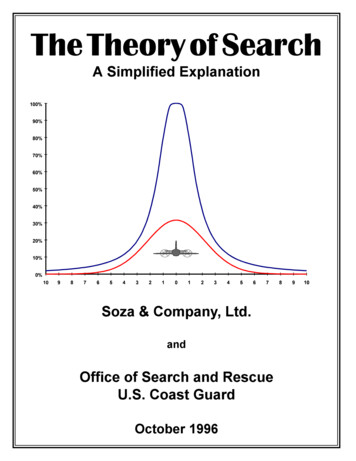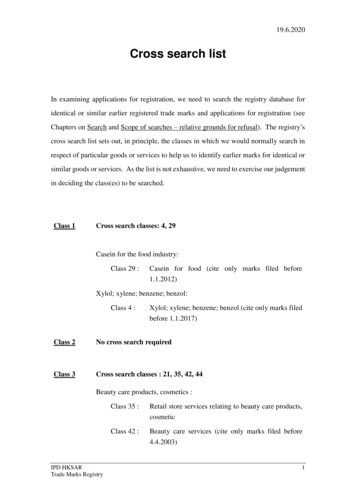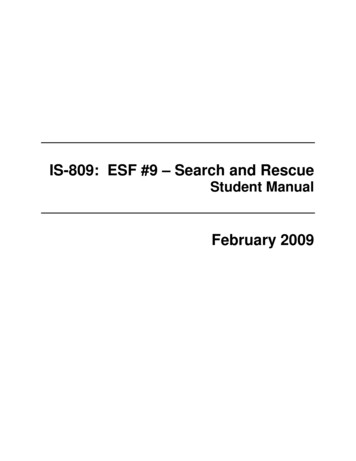
Transcription
The Theory of SearchA Simplified ExplanationSoza & Company, Ltd.andOffice of Search and RescueU.S. Coast GuardOctober 1996Delivery Order Number 96-F-HNG040Under Contract Number DTCG23-95-D-HMS026
The Theory of SearchTable of ContentsThe Theory of Search: A Simplified ExplanationTable of ContentsChapter 1: Introduction . 1-11.1Introduction. 1-11.2Practical Aspects of SAR and Searching . 1-21.3Practical Examples of Search Activity . 1-31.4Search Object Detection and Recognition . 1-41.5Search Object Motion . 1-61.6Searching as Part of a SAR Response . 1-6Chapter 2: Basic Probability Concepts . 2-12.1The Role of Probability in Search . 2-12.2Elements of Successful Searches . 2-12.3Probability of Containment. 2-22.4Probability of Detection. 2-22.5Cumulative POD. 2-32.6Probability of Success . 2-42.7Importance of POS . 2-52.8Adjusting POC . 2-62.9Cumulative POS . 2-62.10 Importance of POSc . 2-82.11 Historical Perspective . 2-9Chapter 3: Probability Density Distributions and Probability Maps. 3-13.1Introduction. 3-13.2Datums . 3-13.3Point Datums. 3-23.4Line Datums. 3-63.5Area Datums . 3-93.6Generalized Datums. 3-10Chapter 4: Detection Models, Lateral Range Curves and Sweep Width . 4-14.1Introduction. 4-14.2Lateral Range Curves. 4-14.3Sweep Width. 4-24.4The Definite Range Model of Detection. 4-34.5M-Beta Detection Model . 4-54.6Inverse Cube Model. 4-74.7Importance of Sweep Width . 4-114.8Assessing the Inverse Cube Model. 4-12i
The Theory of SearchTable of ContentsChapter 5: Searching Areas. 5-15.1Introduction. 5-15.2Search Effort . 5-15.3Coverage . 5-25.4Random Search . 5-25.5Parallel Sweep Searches . 5-55.6Definite Range Model. 5-65.7M-Beta Model. 5-85.8Inverse Cube Model. 5-115.9Search Effort, Coverage and POD . 5-145.10 Effects Leading to Random Search PODs . 5-145.11 Search Conditions . 5-165.12 Navigation. 5-18Chapter 6: Optimal Search Plans. 6-16.1Introduction. 6-16.2Uniform Search Object Location Probability Density Distributions. 6-16.3A Simple Non-Uniform Distribution . 6-36.4Optimal Search Factors. 6-76.5The Circular Normal Distribution. 6-76.6The Additive Principle of Optimal Search . 6-96.7Other Optimization Criteria . 6-16Chapter 7: Conclusion . 7-17.1Introduction. 7-17.2Limitations . 7-17.3Historical Note . 7-27.4Current SAR Environment . 7-27.5Comparing the SSPM and ISPM . 7-37.6Conclusions . 7-97.7Summary . 7-10Appendix A . A-1Table A-1: Normal Distribution Function . A-1Table A-2: Error Function . A-2AfterwordBibliographyii
The Theory of SearchChapter 1Chapter 1Introduction1.1Introduction.The purpose of this paper is to provide the search and rescue (SAR)community with a single document explaining the scientific basis for search planning.Both the Simplified Search Planning Method (SSPM), in place for the last 50 years orso, and recently proposed refinements collectively called the Improved SearchPlanning Method (ISPM), share this basis. The only difference between the twomethods is that the ISPM is a more complete and flexible implementation of basicsearch theory than the SSPM. The main body of this paper explains the basic theory ofsearch. In the last chapter, a comparison is made between the SSPM and ISPM to showwhich method produces search plans having the best chance of succeeding.1.1.1This document was prepared by Mr. J. R. Frost of Soza & Company, Ltd., of Fairfax,Virginia, U.S.A., in cooperation with the U.S. Coast Guard.1.1.2The SSPM is based upon a number of specific assumptions about the search object’sprobable location, the nature of visual detection and the way in which searches areconducted. These assumptions, which are explained later in this paper, are:·····1.1.3The possible search object locations are distributed around a datum position in acircular normal probability distribution;The means of detection is visual;The inverse cube model of visual detection (which is based on its own set ofassumptions and the geometry of instantaneous detection opportunities fromaircraft) is sufficiently accurate under all search conditions;Searches are performed as series of equally spaced parallel sweeps relative to thesearch object; andSpecific levels of coverage or search effort are used for each search in a series ofsearches for a search object.Some refinements have recently been recommended as a more completeimplementation of the basic theory to produce the ISPM. These refinements include···Increased flexibility allowing optimal search plans to be developed for any level ofavailable search effort;Extensions (discussed only briefly in this paper) for use with probabilitydistributions other than the circular normal type; andExtensions (also discussed only briefly) to accomodate varying search conditions.1 1
The Theory of SearchChapter 11.1.4Most of the material in this paper is based on the work of B. O. Koopman asdocumented in his book Search and Screening [1]. However, while Koopmandeveloped the general theory of search, a number of specific assumptions, some listedabove, were apparently made in the application of this theory to the development of theSSPM. Documentation of the rationale for these assumptions and the identity of theoriginal developers of the SSPM seem to have been lost. This paper endeavors toprovide a simplified explanation of Koopman’s theoretical work and show how it hasbeen applied to SAR, including speculations about the rationale behind some of theapparent assumptions made when the theory was translated into practice. This paperwill attempt to explain the theory of search in sufficient detail to provide the generalreader with a practical understanding of the subject, but the level of the mathematicsused will be kept to the minimum required to achieve a pragmatic appreciation of thenecessary concepts. Mathematical rigor may be found in the references provided in thebibliography for readers who require it.1.1.5The discussion of search theory will proceed as follows. The remainder of this chapterwill be devoted to describing the major characteristics of searching, giving some nonSAR examples of common search situations, and placing search operations in theirproper context with respect to the total operation aimed at achieving a particular goal.Chapter 2 develops the three the basic probability concepts that are central to searchtheory. Chapters 3, 4, and 5 then develop each of these concepts in some detail. Chapter6 brings the three central probability concepts back together to explain the theory ofoptimal search. Finally, although the mechanics of the SSPM and ISPM are notdiscussed in detail, a comparison of the results obtained with each is presented inChapter 7.1.2Practical Aspects of SAR and Searching. Before any rescue operation can take place,the survivors must first be found. In many cases, searching is limited to locating thesurvivors in a very small area based on a position provided by the survivors or signalsfrom the survivors’ location (such as those from an emergency position indicating radiobeacon or EPIRB) from which a position can be deduced. Other efforts are intended to“take the search out of search and rescue,” e.g., by maintaining and improving theCospas-Sarsat system and increasing the availability of devices such as EPIRBsthrough cost reduction and, in some cases, carriage regulations. However, electronicemergency beacons will not always be where they are needed, may not always survivethe SAR incident in good working order, may become separated from the survivors,and will always have a limited active life due to the necessity of being battery powered.Although the relative number of SAR incidents where significant searching is requiredmay go down, it is highly unlikely that the need for searching can be completelyeliminated in the foreseeable future. Searching will remain an essential element of SARfor some time to come.Searching becomes necessary when it is known, or there is sufficient concern, that aSAR incident has occurred but there is a large uncertainty as to the location(s) of the1.2.11 2
The Theory of SearchChapter 1survivors. Sometimes investigative efforts can uncover clues which substantiallyreduce the uncertainty about where the survivors are. For this reason, SAR MissionCoordinators (SMCs) should pursue investigative efforts vigorously from the momentof the first alert until the survivors are actually located and rescued. However, in manysituations, especially those involving survivors adrift on the ocean, the uncertainty inthe survivors’ location can increase rapidly with time, making the search problemincreasingly difficult. In addition, the chances of the distressed persons’ continuedsurvival often decrease rapidly with time. For these reasons, searching must often beginearly in the case based on the available clues, however large their uncertainties may be,if a rescue is to be effected.1.2.2Searching is a complex, arduous, time consuming, and expensive task. Thesecharacteristics provide ample justification for trying to “take the search out of searchand rescue.” However, these same characteristics also justify expending a good deal ofeffort in the planning stages to make those search efforts which are necessary asefficient as possible. In the long run, greater efficiency will reduce the amount ofsearch effort required to obtain successful results and will often reduce the timerequired to locate the survivors. That is, better search planning methods can take someof the search effort out of SAR and increase the number of lives saved at the same time.1.2.3Everything in the preceding paragraphs has been self-evident to SMCs and searchplanners for many years. What has been much less evident is that the operation ofsearch actually has a considerable scientific foundation. The SSPM, as published invarious national and international SAR manuals, contains almost no hint of its scientificbackground. On the other hand, the scientific work that has gone into the developmentof devices (and the platforms that carry them) to detect and identify objects fromincreasingly large distances has been widely publicized. While the unaided humansenses, search facilities such as aircraft and vessels, and various detection andnavigation devices and aids are necessary for a successful search, they are notsufficient. The manner in which these components are employed in a search effort isjust as important as the individual capabilities of the components themselves. It wasthis realization which started the development of search theory as a branch of appliedscience.1.3Practical Examples of Search Activity. Searching as an activity is not something that isunique to SAR. It is actually a common activity undertaken for a wide variety ofpurposes in an equally wide variety of settings. The non-SAR examples in thesubparagraphs below may help to put the general problem of search in perspective.1.3.1We all search for something almost every day. Such searches may be for misplacedobjects such as keys, papers, jewelry, etc., or the lavatories in a strange building, or anyof hundreds of other things whose exact location is not immediately known. Usually wetry to think of the most likely location and concentrate our search effort there, until1 3
The Theory of SearchChapter 1either the object is found or continued lack of success makes us wonder if we arelooking in the right place. As we will see later in this paper, this intuitive approach tosearch planning is supported by the mathematics of search theory. Another thing dailyexperience teaches is that an organized pattern of search is more likely to succeed thancasting about randomly, especially if the object is small or blends with its background.1.3.2Archeologists search for lost cities by looking for clues in ancient writings and records,examining the geology of the region, interviewing indigenous peoples, and thenphysically searching for evidence at the site where the ancient city is thought to havestood. In other words, a substantial initial investigative effort is made to reduce theuncertainty about the ancient city’s probable location. Once the search area is reducedto a manageable size, a carefully planned and organized physical search is undertakenfor further evidence. This is basically how the ancient city of Troy, once thought to bepurely fictional, was found in the last century, over 3,000 years after the Trojan Wardescribed in Homer’s Iliad. Investigation is an important activity in the search planningprocess for the same reason — to reduce uncertainty about the survivors’ location.1.3.3Mining and oil companies search for mineral and petroleum deposits which may beprofitably exploited. Prospectors for such deposits look first for large-scale geologicfeatures which indicate the minerals they are seeking are likely to be nearby. When oneis found, they often detonate small amounts of carefully placed explosives in thevicinity, then record and analyze the seismic consequences. This allows them to reducethe uncertainty about whether deposits are present. If there are indications of mineralsor oil, the seismic data may also provide indicators about the size of the deposit as wellas a better (less uncertain) estimate of its exact location. If the results of the seismic“search” are encouraging, then a more detailed, and expensive, search may beundertaken in the form of drilling, tunneling, or limited excavation. While each of thesesteps tends to reduce the uncertainty about whether a deposit exists and can be mined,uncertainty about whether a profit will be made often remains significantly high forquite some time after mining operations have begun.1.4Search Object Detection and Recognition. To succeed in finding an object, it isnecessary to both detect the object and recognize it as the object being sought. Whenthe object is in plain view and sufficiently close to the observer, its recognition is soimmediate that detection and recognition seem to happen as a single act. In most searchproblems, however, recognition can easily be a matter of real difficulty apart fromdetection. Detection occurs when the searcher perceives a set of sensory impressionsindicating the presence of an object. Recognition requires interpretation of theseimpressions to determine their source or cause. With detection equipment, what isperceived may be “blips” on a radar screen or sounds in an ear-phone and it isnecessary to interpret these clues, in light of all other available information, to decidewhether they are caused by the object of the search.1 4
The Theory of Search1.4.1Chapter 1Three factors are involved in the act of recognition:1. Factors of a physical order, such as the nature and properties of the search object,those of the detecting equipment, and those of the environment.2. The time and place of the detection, capabilities and likely behavior of thesurvivors, and any correlation with recent reports or events.3. The psychological capability of humans to “recognize” — as in the recognition ofan individual face.1.4.2Electronic sensors typically perform only the detection function although in somecases, primarily of a military nature, electronic or sonic “signatures” can be used foridentification purposes. For all practical purposes, electronic sensors used in SARsearches do not perform the recognition function. One exception is the 406 MHzEPIRB. Beacons of this type emit a data stream to orbiting satellites which includes aunique serial number and possibly a code indicating the nature of the incident. If thebeacon has been properly registered, information about the owner, craft and lifesavingequipment can be retrieved from a database. However, search facilities on scene onlyreceive a 121.5 MHz homing signal that contains no recognition data.1.4.3The detection capabilities of electronic sensors are constantly being improved so thatsmaller and smaller objects may be detected at greater and greater distances. However,we must not lose sight of the fact that the act of recognition is essential. Sometimeselectronic information alone can be used to determine that an object is not the searchobject. The International Ice Patrol uses a Side-Looking Airborne Radar (SLAR) todetect, record on film, and plot the locations of icebergs. However, SLAR detects shipsas well as icebergs. Detections of ships are eliminated by computing the course andspeed of each detected object from the SLAR data. (Overlapping sweeps are used sothat each object is normally detected at least twice during a patrol.) Course and speedinformation allows the SLAR operators to separate vessels from icebergs withoutactually sighting either. Similar techniques can sometimes be used in SAR searches.However, in SAR, recognition often requires visual inspection of each detected objectto determine whether it is the search object. This fact, and the fact that most SARsearch objects are difficult to detect electronically, are the primary reasons the humaneye remains the sensor of choice in SAR searches.1.5Search Object Motion. In subparagraph 1.2.1 above, it was observed that commonexperience teaches us that organized searching usually produces better results thanrandom, disorganized efforts. However, the objects of many common, everydaysearches are stationary and do not move as the search progresses whereas the objects ofSAR searches are often in motion. Survivors adrift on the ocean move with the windsand currents. Survivors on land often move to find shelter or improve theircircumstances in some other way. When organizing a search, it is important to estimatethe motion of the survivors and account for it in determining both where to search and1 5
The Theory of SearchChapter 1how to search. The frame of reference for any regular pattern of search must be fixedon the search object or at least the best estimate of its location and movement duringthe search effort. Otherwise, the results can easily be even worse than those of randomsearch.1.6Searching as Part of a SAR Response. When the SAR system is alerted that a SARincident has, or may have, occurred, the information contained in the initial alert isusually incomplete. The alert may originate from a concern that a SAR incident mayhave occurred, making the very existence of the incident uncertain. Even when it isknown that a SAR incident has occurred, the time, place, and nature of the incident maynot be precisely known. Many other important pieces of information may be eithermissing altogether or known only within very broad limits. All this means the SMC isoften initially faced with a mystery having few clues and some of those may beirrelevant, unreliable, or both.1.6.1The way to solve a mystery, of course, is through investigative efforts; andinvestigative efforts generally proceed via a process of elimination. Most investigationsfollow a pattern like that shown below.1. Evaluate the initial clues.2. Develop initial theories, or scenarios, consistent with the clues, about what mayhave happened or what may be true.3. Actively seek more clues.4. Evaluate and rank all clues found to date according to relevance and reliability.5. Eliminate previous scenarios when they are no longer consistent with theaccumulated body of evidence. Develop new scenarios, if needed, which areconsistent with the accumulated body of evidence.6. Return to step (3) until the mystery is solved.1.6.2One way to actively seek more clues is to search those areas where the search objectmay be located. Searches can provide either “positive” or “negative” clues.1.6.2.1When actual evidence of the SAR incident or subsequent survivor movement is found,then the clues are “positive.” For example, finding debris that can be identified asbelonging to a missing vessel is a positive clue that a SAR incident has occurred.Depending on the discovery, such evidence may also provide positive clues about thetime, place and nature of the incident.1.6.2.2Searching an area without finding anything is a “negative” clue. If the search was 100%effective, then it is clear that the search object was not in the area at the time of thesearch. This information may allow some previous scenarios to be eliminated. If thesearch object is known to be stationary, such results also eliminate the need to searchthe area again at a future time. Usually, searches are not 100% effective and so they1 6
The Theory of SearchChapter 1only reduce, rather than eliminate, the likelihood of the search object being in the areawhen it was searched. Even so, such a reduction is an indicator that perhaps futuresearch efforts would be better expended elsewhere. Exactly how search effort should beallocated will be discussed in Chapter 6.1.6.3Although searching can be the most expensive part of a SAR response, involving themost people and equipment, it must be viewed as only a portion of a larger operation.Other investigative efforts besides active searching should continue unabated. All ofthe available clues and information should be reviewed and re-evaluated at least daily.Plans need to be made for the next search effort in case the current effort fails. Otheractivities, as well as the search itself, need to be coordinated. Searching is really justone more investigative tool used to locate survivors. It is needed when other techniqueshave either failed or are not expected to produce results as early as may be necessary tosave lives.1 7
The Theory of SearchChapter 2Chapter 2Basic Probability Concepts2.1The Role of Probability in Search. Every SAR case involving a search is beset withuncertainties. At a minimum, the survivors’ location is uncertain; otherwise, therewould be no need to search. Usually there are uncertainties in other importantquantities, including such things as:····when, where and possibly whether a SAR incident actually occurred;the direction and speed of survivors’ movements since their locations were lastknown;the size and other characteristics of the search object affecting the ability of searchfacilities to detect it; andenvironmental factors affecting search object motion, search facility sensorperformance, and survivor behavior.These are just a few of the factors the search planner must take into account. The natureand impact of these uncertainties on search planning and operations can be understoodquantitatively only in terms of the mathematical discipline known as probability theory.2.2Elements of Successful Searches. For any search to be successful, two things must betrue. First, searchers must be looking in the right place. Second, searchers must becapable of detecting the search object. Since the exact location of the search object isnever known in advance, “looking in the right place” means searching areas that haveat least some probability of containing the search object. Similarly, the searchers mustbe using sensors that have at least some probability of detecting the search object. Ifeither of these probabilities is zero, the search is doomed to fail. Only if bothprobabilities are 100% is the search guaranteed to succeed. In actual operations, theprobability of success lies somewhere between these extremes. In other words, theprobability, or likelihood, that a search will succeed in locating the search objectdepends on two other probabilities:(1) the probability that the search object is actually in the area searched; and(2) the probability of detecting the search object if it is there.Each of these in turn depends on a number of other factors. For example, the ability todetect the search object depends on such things as the type and characteristics of thesensors used, the environmental conditions in the search area, the way the sensors areemployed, etc. The likelihood of the search object being in the search area depends onthe amount and ac
documented in his book Search and Screening [1]. However, while Koopman developed the general theory of search, a number of specific assumptions, some listed above, were apparently made in the application of this theory to the development of the SSPM. Documentation of th










